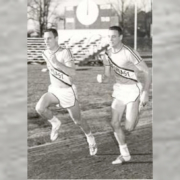Colorado’s Styron Twins
Hello Track Fans,
I am going to tell you about two early sprint and hurdle greats from the late 50’s and early 60’s, that came out of the Colorado ranks.
Dave Styron and twin brother Don Styron. They attended Wheat Ridge High School and later went on to North East Louisiana State which is called UL Monroe now. They Graduated in 1957 and competed at the state meet in Boulder, Colorado. At that meet Wheat Ridge as a team took 3rd after being the favorite going in that year. Dave the sprinter of the two Styron’s took a back seat to Don Gatewood of Manual HS in the 100 yard dash and the 220 yard dash which in those days was ran on a straight away. In the 100 yard dash Gatewood would need a State Meet Record equaling 9.9 to defeat Dave. Brother Don had what one would call a bad meet as in the 120 yard hurdles, after leading the State with a 14.4 fell and finished last to 1957 and 1958 Champion Ron Leitch of Grand Junction timed in 14.8. In the 180 yard low hurdles also leading the State with a 19.4 going into the State Meet tripped going over the last hurdle and finished 2nd, again to Ron Leitch who’s time was 20.2. Leitch also won the 180 yard lows in 1958. Remember the 180 yard lows were also ran on a straight away like the 220 yard dash. However the Styron Brothers did team up on the 880 yard Relay and Mile Relay to take the AA State Titles. Those meets where ran on Cinder tracks not the fast Mondo tracks of today. A note that will play a roll as we continue to talk about the Twins was their Wheat Ridge coach. In 1957 Lew Hartzog would later become the NE Louisiana Coach. On another note Roger Beuner of Golden High School the 1958 100 yard and 220 yard dash Champion would be recruited by Hartzog also to attend NE LA. Which he did. Roger did well at NE LA also with a 9.6 100 yard dash and 20.5w 220 yard dash PR’s. Think they had a good 440 yard and 880 yard relay teams? The Twins are still ranked in the After High School lists in the 100 Meters, 200 Meters, 110 Meter Hurdles and the 400 Meter hurdles, 60+ years later!! WOW!!
The next segment of this post is from the Louisiana Sports Hall of Fame and Wikipedia. Dave is talked about first.
Induction Year: 1977
The Styron twins weren’t part of a package deal when Northeast State College (Northeast Louisiana University, University of Louisiana-Monroe) hired Lew Hartzog as its track and field coach in August of 1957.
No four-year school offered athletic scholarships to twin brothers Dave Styron and Don Styron after their senior year at Wheat Ridge, Colo., High School. Neither of them won an individual event in the state meet, as Dave took third place in the broad jump (now the long jump) and Don finished second in the 180-yard low hurdles.
When he got the Northeast job, Hartzog knew it was too late to recruit anybody in Louisiana.
Hartzog coached the Styrons in football and track at Wheat Ridge, and watched them play basketball for two years. He thought they had potential that hadn’t been developed yet.
He was right.
The Styrons were approaching the end of a summer job at cattle and hay ranches near Jackson Hole, Wyoming, when the telephone rang one night after a long day of branding cows and sticking hay. Dave answered. Moments later, he told his twin brother, “It’s Hartzog. He wants to know if we want to go to college.”
“Are you kidding?” Don replied.
They had never heard of Monroe, La., or Northeast State College. But at that moment, any place which was a reasonable distance from Jackson Hole sounded like paradise to a pair of 17-year-old boys who were about to develop into the fastest set of twin brothers in track and field history.
Before Hartzog and the Styrons could build a track team at Northeast, they had to build a track. But the following May, Dave won the 100 yard dash and 220 yard dash in the Gulf States Conference meet, and finished second to record-breaking Don Troutman of McNeese State in the broad jump. Don was runner-up to Joel Thomas of Louisiana Tech in both hurdles races, and both of them ran on 440-yard relay team that set the meet record. Northeast finished a strong third in team standings as McNeese State came from behind on the final event, the mile relay, to end Northwestern State’s streak of five consecutive titles.
In 1959, the Styrons blasted into orbit. “We went crazy,” said Dave Styron.
It started in Ruston on March 17, when Dave beat Louisiana Tech’s Pat Garrett in the 100 yard dash and set an American junior record with 9.4 seconds.
“That was the first time I realized we might have world class potential,” Dave recalled.
The climax of the 1959 season was the conference meet, with Northeast beating runner-up Northwestern State by 22 points to win its first conference title in any sport.
Dave Styron tied the 100 record (9.7), won the 220 (21.1, with Don second) and finished fourth in the broad jump. Don swept the hurdles, breaking Thomas’ records with 14.2 in the 120-yard highs in the 220-yard lows. Both ran on winning 440 and mile relay teams.
The Styron twins were free sprits with crewcuts. Nobody trained harder on the track, but they did their share of carousing. When they stayed in Monroe to train for the 1959 Sugar Bowl meet, Dave shot himself in the leg practicing his “quick-draw.” Eight days later, he ran a great leg in the mile relay at New Orleans.
The 1960 season was perfect. Northeast posted a 14-0 record, including a one-sided victory in the Florida Relays, and rolled up 101-1/2 points in the GSC meet to beat runner-up Louisiana Tech by 26-1/2 points.
The Styrons had a hand in six record-breaking performances in the GSC meet as Dave lowered meet records to 9.6 in the 100 and 20.6 in the 200. His brother broke is own year-old records with 14.1 and 22.3, respectively, and they helped Northeast shatter 440 and mile relay records.
The Styrons weren’t the only Olympic prospects on the 1960 Northeast team. Shreveport freshman Jerry Dyes went over 50 feet in the hop, step and jump (now called the triple jump), and fouled by a quarter-inch on a 51-10 leap that was only 7-1/2 inches short of the American record.
“I think I’ll be in Rome watching at least one of my boys compete,” Hartzog said. “And it might be more than one.”
He took all three to the Olympic trials at Stanford University, making the trip by automobile. After the long collegiate season and a few AAU meets in June, they were competing for berths on the strongest United States Olympic team ever assembled.
One unknown athlete from a North Louisiana college made the Olympic team, but he wasn’t one of the Northeast trio. Stone Johnson of Grambling broke the world record for the 200 meter dash in a semifinal heat with 20.5 and then finished second to Ray Norton in the finals as Norton equaled the day-old record.
Dave Styron had the best shot of the three Northeast athletes, but he ran afoul of a new false start rule in the 100 meter dash and was disqualified for jumping the gun twice. Ironically, Armin Hary of Germany – who won the 100 at Rome, ending American dominance dating back to 1928 – did the same thing in the Olympics, but wasn’t penalized when he and Dave Sime broke without a gun.
“I followed another guy out of the blocks the first time, along with everybody else,” Dave said. “The gun didn’t fire, and I didn’t realize everybody had been charged with a false start until it was too late.”
Norton, ranked No.1 in the world in both sprints the previous year, bombed out in the Olympics. He was sixth in both races, and then ran out of the exchange zone in the 400 meter relay to spoil a world record performance and end the U.S. streak of eight consecutive gold medals.
The Styrons followed Hartzog to Southern Illinois University that fall, but returned to Northeast because of a problem in transferring their credits. They led Northeast to another GSV championship in 1962 and were co-winners of the GSC “Athlete of the Year” award three times.
Running on cinder tracks, Dave Styron had personal bests for 9.3 for 100 yards, 10 seconds flat for 100 meters, 45.7 for 400 meters, 25-plus in the broad jump, 6-6 ¾ in the high jump and 14-1 in the pole vault. If he hadn’t been so small (5-10, 145 pounds), he would’ve given the decathlon a shot. He was world class in half of the 10 events.
Don Styron
Sport: Track and Field
Induction Year: 1977
University: UL-Monroe
Induction Year: 1977
When he won three gold medals in the 1956 Melbourne Olympics, sprinter Bobby Morrow relied on getting 11 hours’ sleep a night to keep up his strength.
Four years later, twin brothers Don Styron and Dave Styron used the same strategy to rank among the world’s best athletes in the specialties.
They might have a combined total of 11 hours’ sleep before major meets – 5 1/2 apiece for Don and Dave.
“If they got three or four hours sleep,” recalled former teammate Jerry Dyes, “they could run with anybody in the world.”
Former LSU track and field coach Murrell “Boots” Garland, who considered himself somewhat of an authority on the subject, said the Styrons’ reputation for being world class drinkers was greatly exaggerated. “They did plenty of carousing, but not much drinking,” Garland said. “I’ve spilled more liquor on the bar than they ever drank.”
Lew Hartzog, who coached the Styrons at Wheat Ridge, Colo., High School and Northeast State College (Northeast Louisiana University, Univ. of Louisiana-Monroe) was a great track coach, but he didn’t exactly run a tight ship. Any of his athletes would’ve had a hard time matching their coach’s reputation as a free spirit.
When Hartzog took the Styrons and Dyes to the 1960 Olympic Trials at Stanford by automobile, they were on the road for four weeks – with a two-day layover in Juarez, Mexico, highlighted by Hartzog’s leap from a second-floor balcony into a motel swimming pool.
“Looking back,” Dyes recalled when the Styrons were inducted into the Louisiana Sports Hall of Fame in 1977, “I don’t think stopping in Juarez was a very good idea.”
In the Olympic Trials, the field for the 400-meter intermediate hurdles was the fastest ever assembled.
It included world record holder Glenn Davis, the defending Olympic champion, and the other two medalists in the Melbourne Game – Eddie Southern and Josh Culbreath. Whoever qualified for the U.S. team would be part of another 1-2-3 sweep in Rome.
Don Styron, running the event for only the sixth time in his life, had a personal best of 49.9. Leading the pack at 300 meters, he hit the eighth hurdler and lost his balance for a few strides.
“I lost my concentration, and wasn’t able to get my rhythm back,” he recalled. Despite the mishap, he finished sixth with 50.3 – one-tenth behind Culbreath. Davis won in 49.5 and the next three broke 50 seconds – but Southern, Culbreath and Styron didn’t make the team.
The following spring, Northeast won the Florida Relays as Dave Styron won the 100, Don Styron won the high hurdles and both ran on winning 440-yard and mile relay teams. The Indians rolled up 50 1/2 points to 28 for runner-up Florida.
When Northeast beat LSU’s Southeastern Conference champions 55-53, the Styrons accounted for 36 points. Don Styron had a personal best in the high hurdles that day, beating Dickie Durham of LSU with 13.9.
Later in the 22-yard low hurdles, he lowered the world record to 21.9 seconds.
The 220-yard low hurdles was a standard collegiate event at that time, but it was dropped in favor of the 440-yard intermediate hurdles.
Two years in a row, Track and Field News selected Don Styron as the world’s best triple hurdler – combining the 120-yard highs, 220-yard lows ad 440-yard intermediate hurdles. He was the national AAU champion in the 220-yard lows in 1961, the next-to-last time the event was held in a national meet.
Don Styron won his first race with his younger brother on March 18, 1940, when he was born 20 minutes before Dave.
The twins played football and basketball at Wheat Ridge, Colo., and also participated in track and field. But they enjoyed only modest success. In the 1957 state meet, Don Styron was second in the 180-yard low hurdles and Dave Styron was third in the broad jump (now the long jump).
When Hartzog got the Northeast job a couple of months later, he located the Styrons working on a summer job at hay and cattle ranches near Jackson Hole, Wyoming, and gave them the only scholarship offer they received from a four-year school.
At Northeast, they had to build a track before they could build one of the nation’s best collegiate teams. “We had to borrow hurdles from Neville High and practice on the football field,” Don Styron recalled.
Social barriers also blocked their development as world-class athletes, because a Louisiana law did not allow state schools to participate in integrated events at that time. That prevented Northeast from winning national titles, and cut down on its athletes’ opportunities for top competition.
The Styrons shared Gulf States Conference “Athlete of the Year” honors three years, leading the school to its first three conference titles in any sport.
Two years after he completed his collegiate eligibility, Don Styron tried to come back and win a berth on the 1964 U.S. Olympic team. In the 400-meter intermediate hurdles, he was runner-up to Eddie Southern in the Texas Relays and runner-up to Cliff Cushman in the Kansas Relays. But the Amateur Athletic Union offered little of no help to world class athletes after their collegiate eligibility expired, and his comeback bid ended in frustration and failure.
He was able to fly to Corvallis, Oregon, for a qualifying meet, and finished second. But he ran out of money, and the AAU officials – who promised per diem expenses to the top three in each event – said they would mail a check.
Meanwhile, Don had to hitchhike to Los Angeles – where Southern Cal coach Jess Mortensen allowed him to stay in the athletic dorm while he trained with USC athletes, and then hitchhike across the nation to compete in the Olympic Trials at New Brunswick, N.J. But the time he arrived in New Brunswick, he had lost his conditioning and finished last in a qualifying heat.
More than 25 years later, he was still waiting for the check.
Don Styron
Donald Augustus Styron (born March 18, 1940) is the world record holder in the 200 meter low hurdles. He remains the current world record holder partly because the event has not been run frequently by elite athletes since the early 1960s.[1]
Hurdler Don Styron was an identical twin, his younger brother (by 24 minutes) being David Styron (a sprinter). The brothers only had come to Colorado from southeast Kansas in 1955. During the depression, the boys lived on a farm without electricity or running water until seventh grade. They would race each other home from their one room schoolhouse. The move to Denver was a major social change. First they went to North High School where they were victims of a fight every day. The 5 ft 10 in (1.77 m) 140 pounds (64 kg) brothers demanded a change. Them went west down 32nd Avenue to Wheat Ridge High School where they ran for track coach, Lew Hartzog. With points from the twins in multiple events, Wheat Ridge dominated local competition. After their graduation in 1957, Hartzog took a job establishing a new track program at Northeast Louisiana State College. Hartzog went back to recruit his former star athletes, finding them bailing hay in Wyoming. When they arrived in Monroe, Louisiana, they had to work out at a local high school. They had to help build their own track. Early on, David set the American Junior record in the 100 yard dash at 9.4.[2] Both brothers were inducted into the Louisiana Sports Hall of Fame in 1977.
I hope all of you have enjoyed these articles
GO FAST
GOD Bless
Tim Rutherford







Went to Wheat Ridge High School, ran track with the Styrons under Lew Hartzog (good guy), graduated in 1958. I say “ran with” the Styrons – more like, watched their smoke from afar.